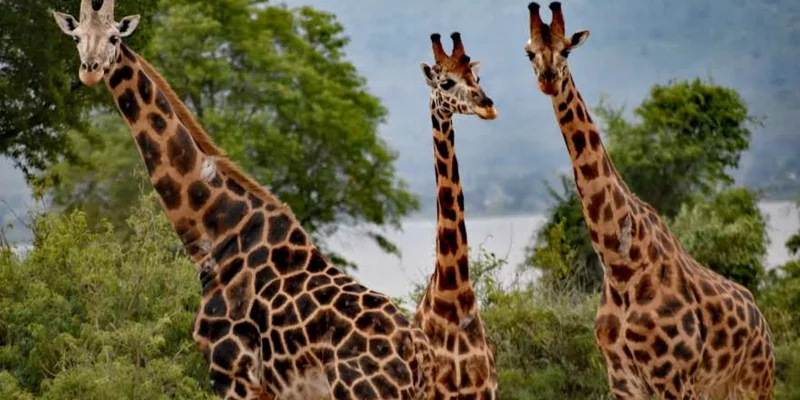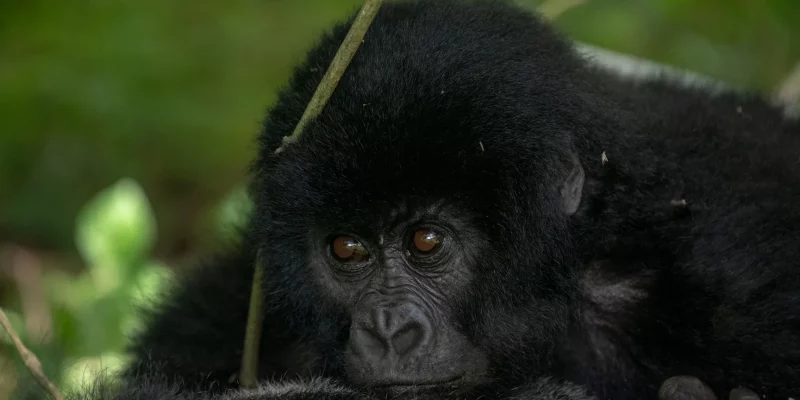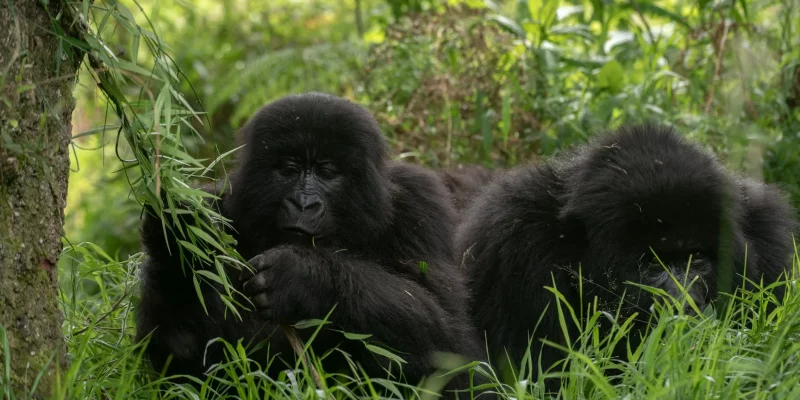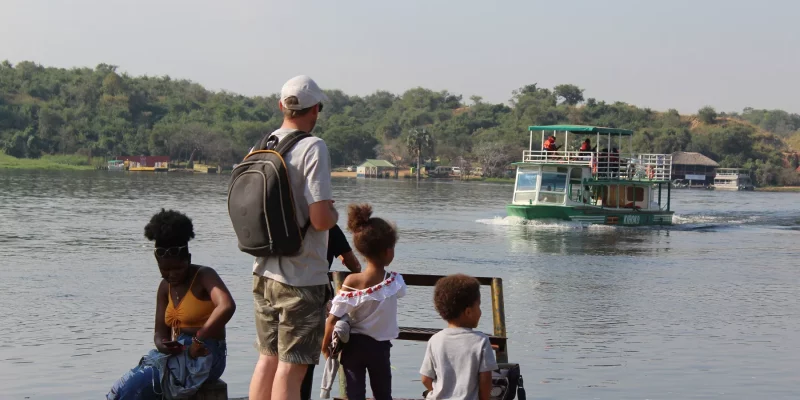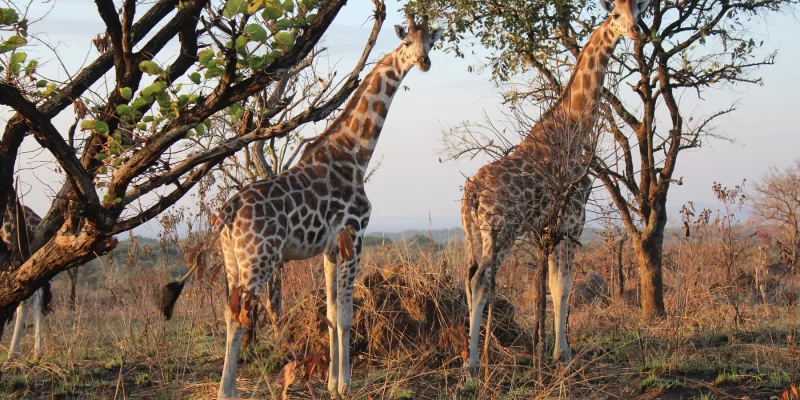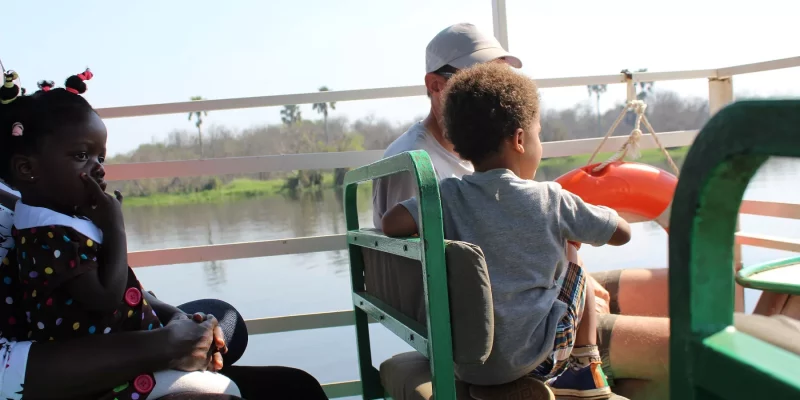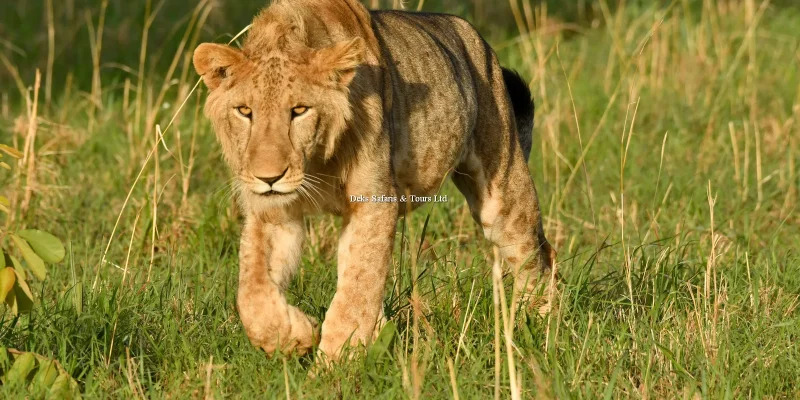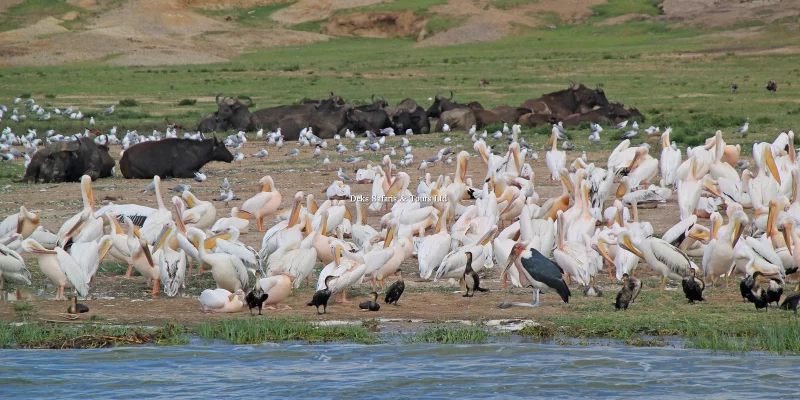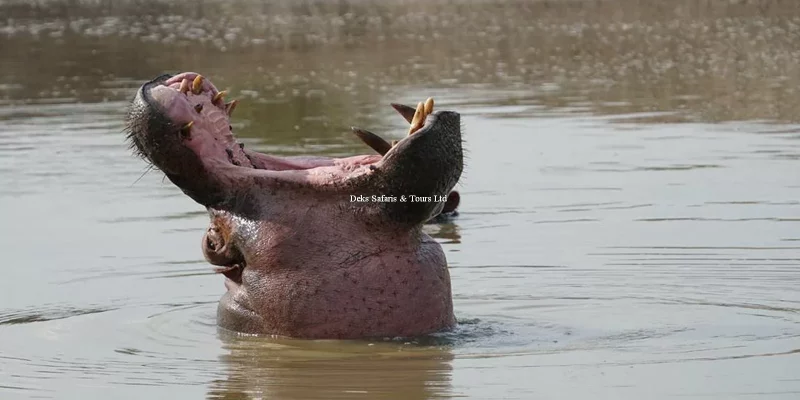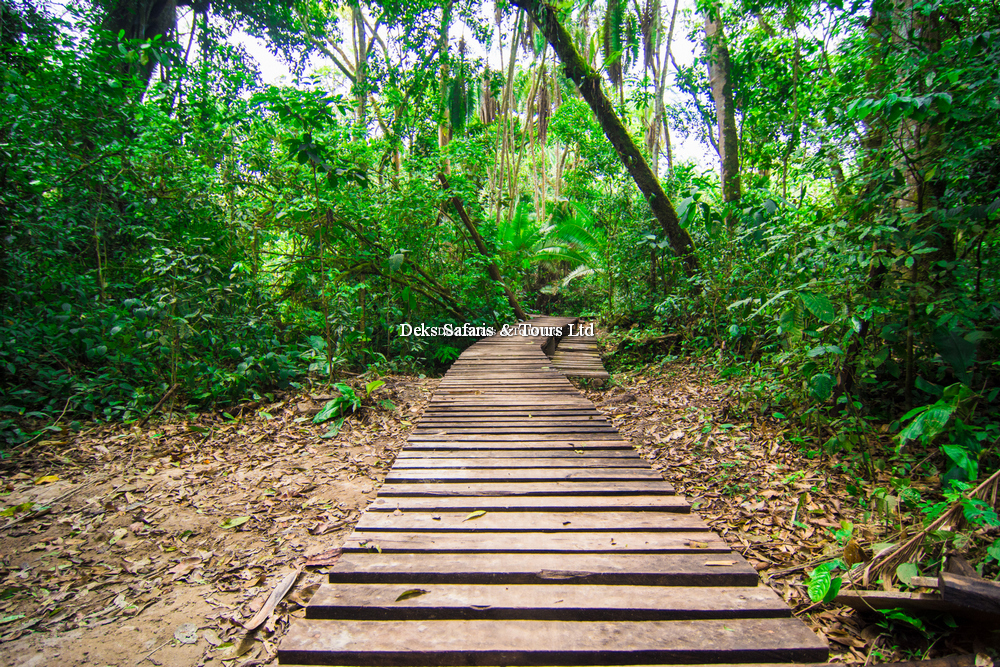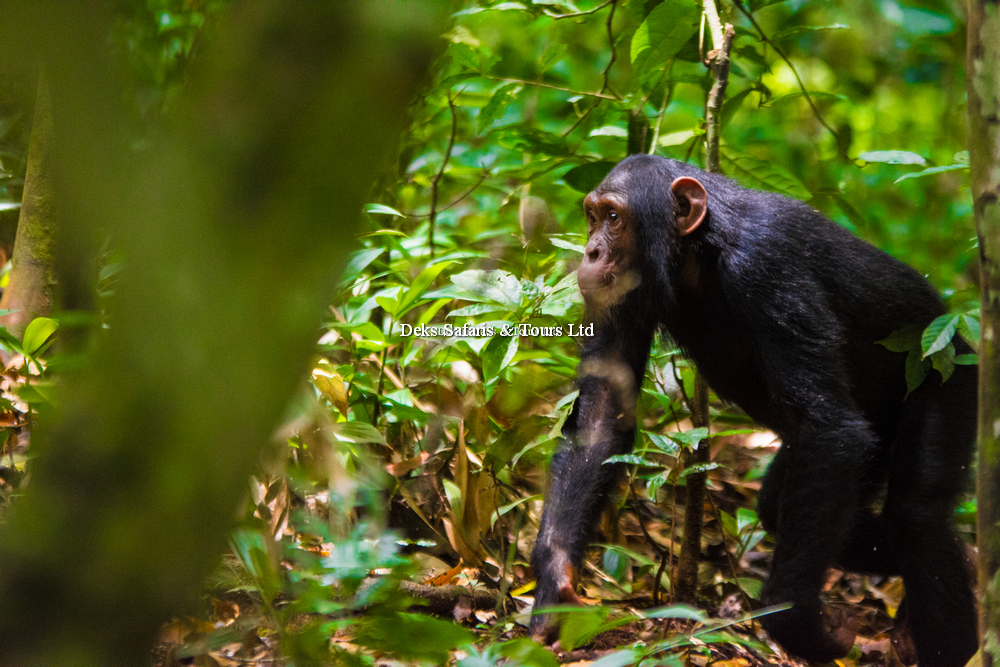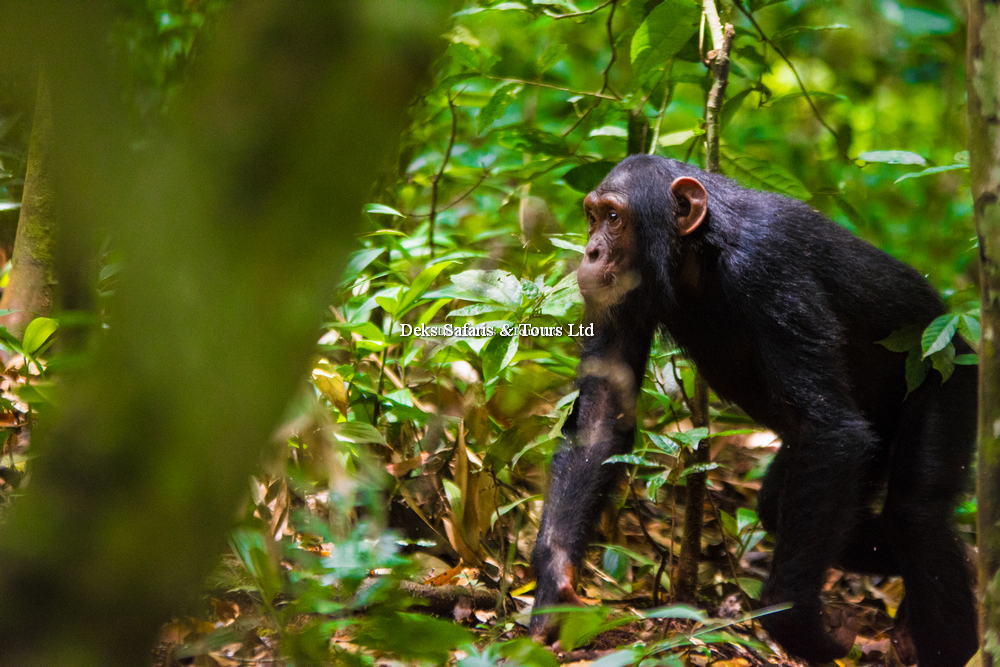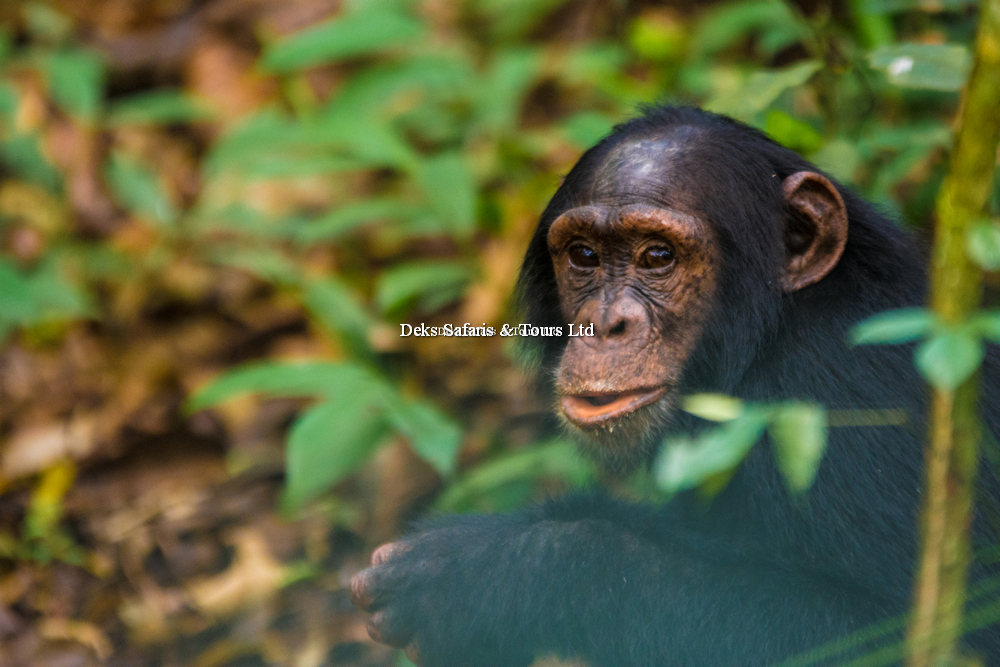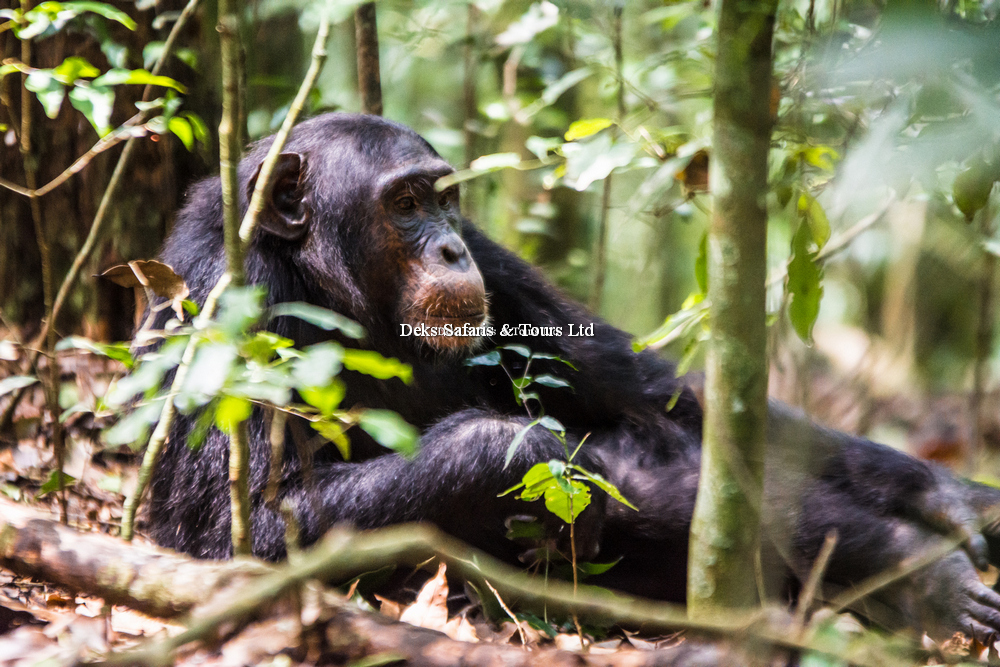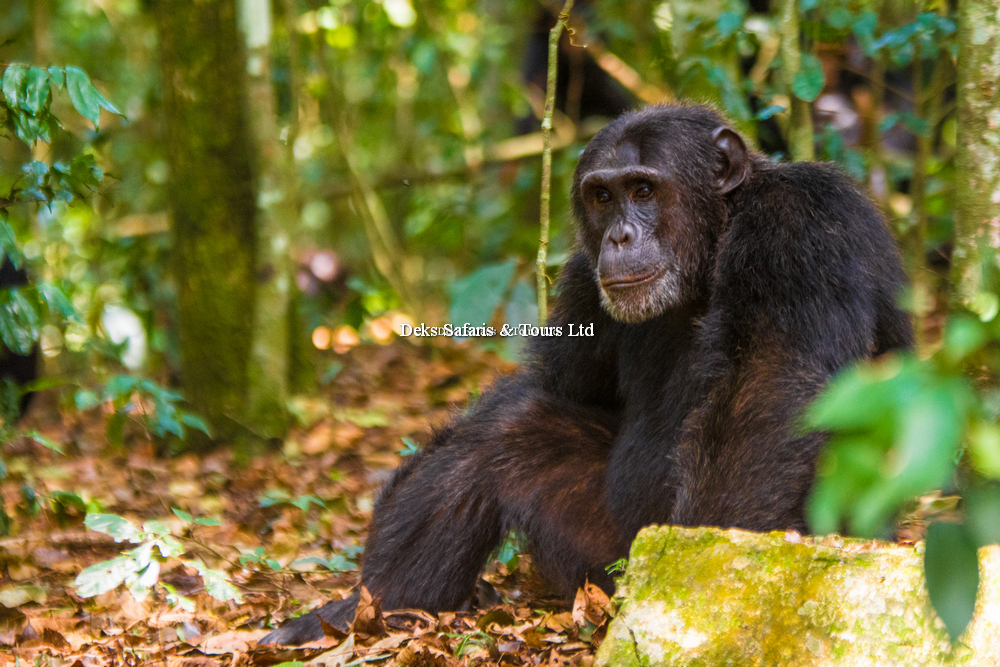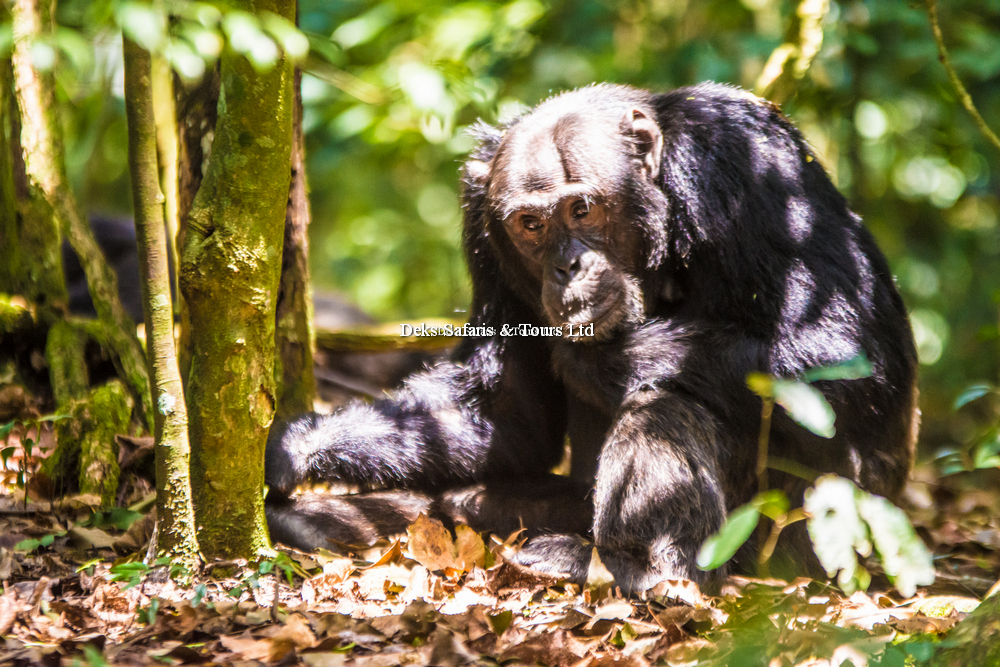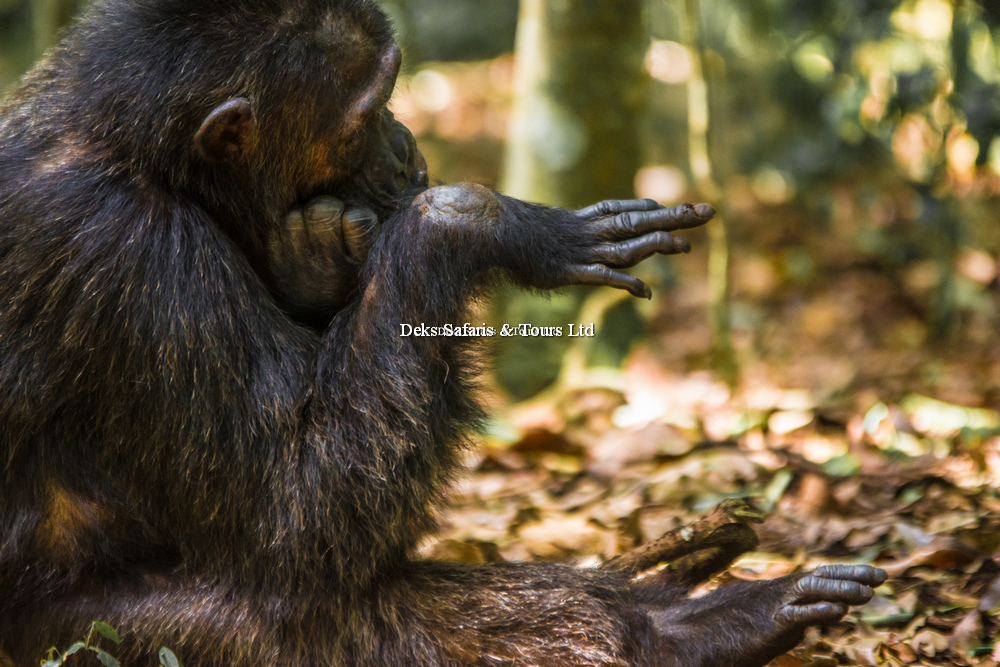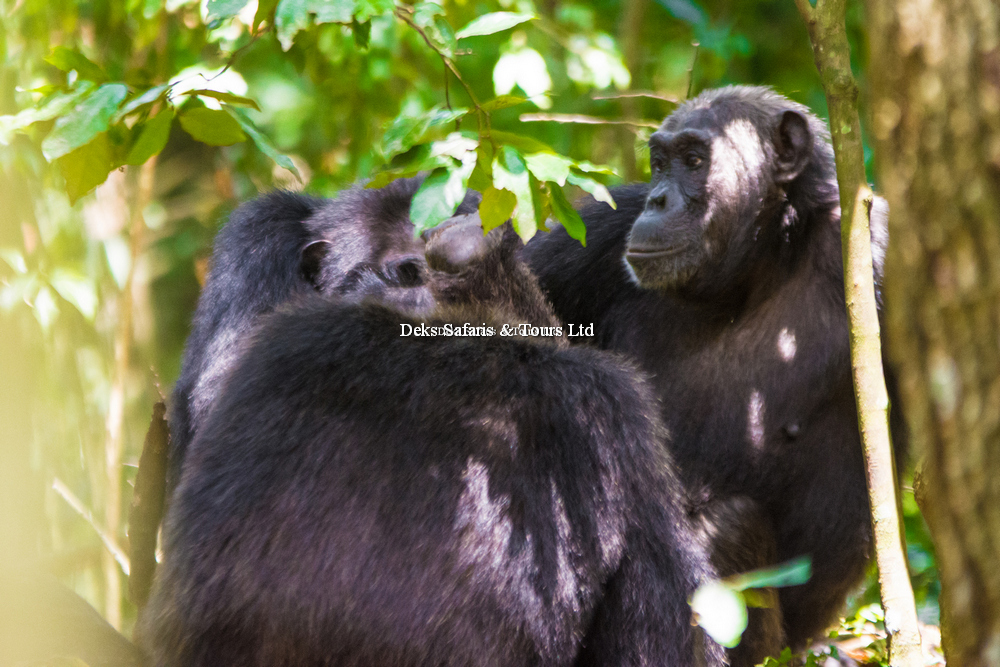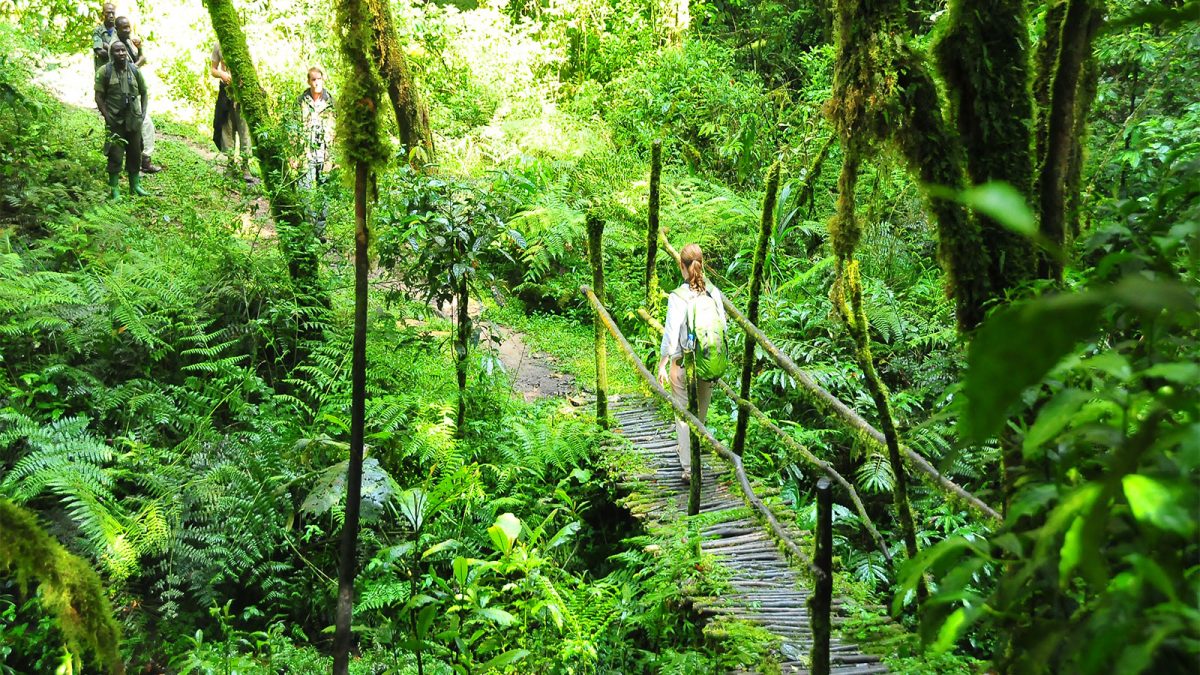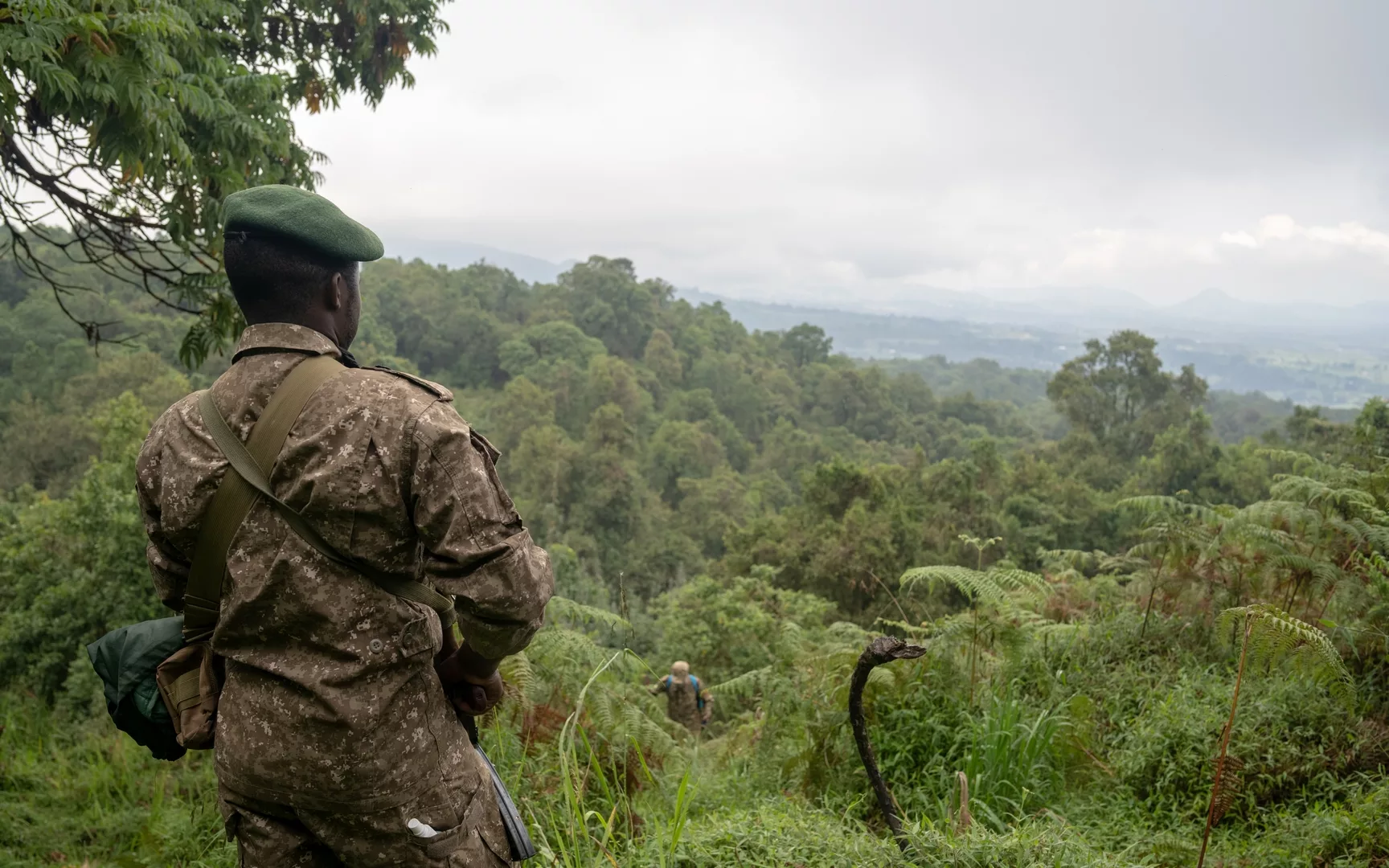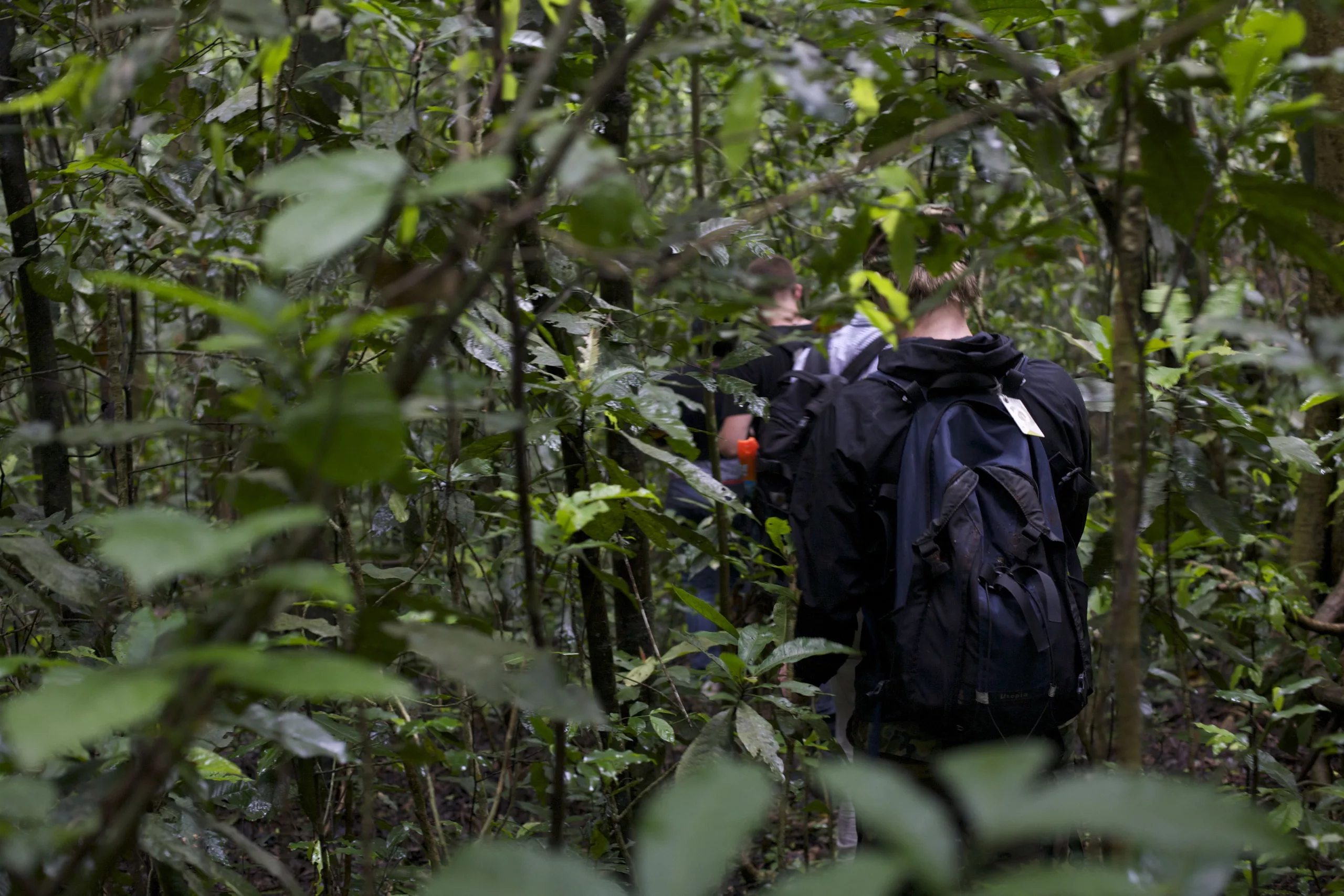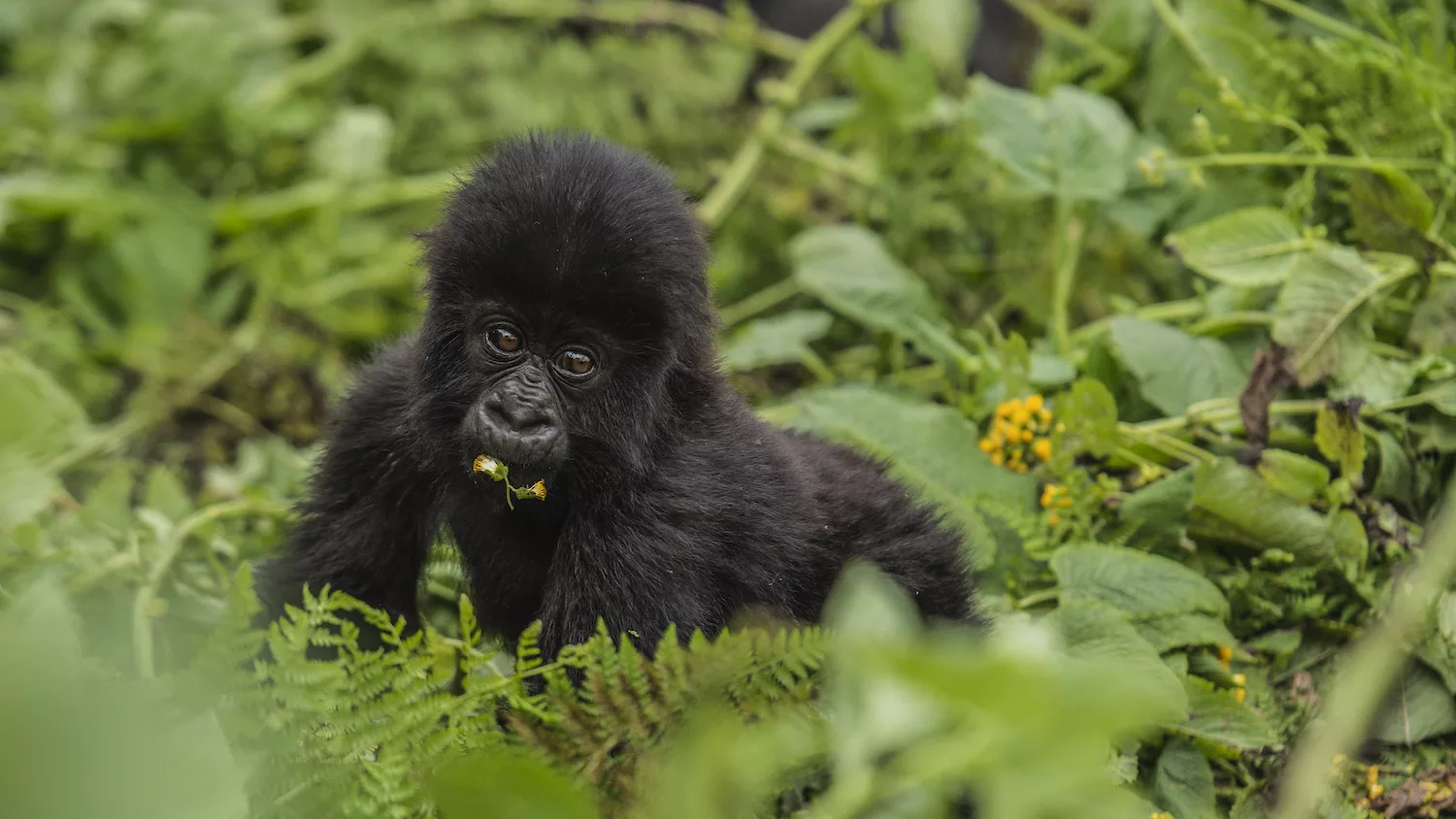A Complete Guide for Chimpanzee Tracking in Uganda
Are you considering a journey to partake in chimpanzee tracking in Uganda? Alternatively, are you simply intrigued by what such an experience entails? Whatever your motivation, we believe this guide will prove invaluable. Drawing from our own firsthand encounters tracking to observe chimpanzees in Uganda, we’ve compiled a comprehensive resource. Alongside gorilla tracking, chimpanzee tracking stands as a favored pursuit among Uganda’s visitors.
This guide encompasses everything you need to know—from prime locations for encountering chimpanzees in Uganda, to associated costs, the level of difficulty involved in chimpanzee Tracking, essential items to pack, and much more. Additionally, we’ll recount our own chimpanzee tracking adventure in Kibale Forest to offer you a glimpse into the actual experience. Naturally, our narrative will be complemented by a plethora of accompanying photographs, and I’ll also share some pointers on capturing exceptional photos during your trek. While this guide is centered on chimpanzee tracking in Uganda, many sections are applicable to similar excursions in other countries as well.
Over 40 Uganda Wildlife, Gorilla Trekking, and Chimpanzee / Chimp Tracking Tours
5 Days Murchison Falls Safari in Uganda
The 5 Days Murchison Falls Safari Uganda wildlife tours will allow you to explore the world’s longest river, possibly the most powerful waterfall in the world, located along…
5 Days Uganda Gorilla Trekking Trip
This 5 Days Uganda Gorilla Trekking Trip and Wildlife Tour from Kampala City takes you to two magnificent Ugandan National Parks, including Queen Elizabeth National Park.
7 Days 1 Week Uganda Safari
These 7 Days 1 Week Uganda Safari – Wildlife Safari & Gorilla Trek in Uganda will take you through the pearl of Africa – exclusive Uganda and experience an abundance.
7 Days Best of Uganda Tour
This is another fun 7 days tour to the best of Uganda. Take Uganda’s best 7-day Best Uganda tour to the world’s thundering waterfall and find the nearest great ape, the chimpanzee.
9 Days Family Trip in Uganda
Combining wildlife, rhino tracking, and a Ugandan cruise, this 9 Days Family Trip in Uganda will bring the best of what Uganda has to offer to your family. Activities for all ages.
15 Days Uganda Bird Safari
This is the best of Uganda Bird Watching Safari & Primates Trip as it will take our client to enjoy the best birding experience while learning about almost all birds of Uganda.
19 Days Birding & Wildlife Trip
This is the best 19 Days Birding Safari & Wildlife Trip to Uganda as it will take our client to enjoy the best birding experience while learning about almost all birds of Uganda.
20 Days Birding Safari in Uganda
20 Days Birding Safari Excursion in Uganda takes you to Mabira virgin forest with 312 species, Ziwa rhino sanctuary with 250 bird species, Budongo forest with over 360…
21 Days Uganda Birding Excursion Safari
There is no single destination in the world that can compare to Uganda when it comes to Birding Excursion Safari and its assortment of tourism products. It is a paradise.
10 Days Luxury Uganda BIG-5 Safari
On the 10 Days Luxury Uganda BIG-5 Safari & Primates “Medley’s of Nature in the Pear of Africa”, you will be able to participate in Gorilla trekking in Bwindi forests, Chimpanzee tracking.
Where can you see Chimpanzees in Africa?
Chimpanzees, one of our closest relatives in the animal kingdom, can be observed across various regions of Africa, primarily in the tropical forests of Central and West Africa. One of the most renowned destinations for chimpanzee sightings is the lush rainforests of Uganda, particularly in Kibale National Park and Budongo Forest Reserve. These protected areas offer visitors the opportunity to trek through dense vegetation, accompanied by experienced guides, to witness chimpanzees in their natural habitat. The misty forests of Rwanda’s Volcanoes National Park also provide a chance to encounter these fascinating creatures, often remembered for the groundbreaking research conducted by Dian Fossey.
In addition to Uganda and Rwanda, Tanzania boasts several locations where chimpanzees can be observed, such as Gombe Stream National Park and Mahale Mountains National Park. Gombe Stream, made famous by Jane Goodall’s pioneering research, offers intimate encounters with habituated chimpanzee groups, providing invaluable insights into their behavior and social structure. Similarly, Mahale Mountains National Park, located on the shores of Lake Tanganyika, provides a remote and picturesque setting for chimpanzee tracking amidst towering peaks and pristine beaches. These destinations not only offer unforgettable wildlife experiences but also contribute to the conservation efforts aimed at protecting these endangered primates and their habitats.
Where can you See Chimpanzees in Uganda?
Uganda is renowned for its diverse wildlife and is a prime destination for encountering chimpanzees in their natural habitat. One of the most popular locations for chimpanzee trekking is Kibale National Park, located in the western part of the country. This lush rainforest sanctuary is home to an impressive population of chimpanzees, making it a hotspot for primate enthusiasts and researchers alike. Guided chimpanzee tracking excursions in Kibale offer visitors the chance to observe these intelligent creatures swinging through the trees, foraging for food, and interacting with one another in their social groups.
Another notable destination for chimpanzee viewing in Uganda is Budongo Forest Reserve, situated within the larger Murchison Falls National Park. This dense tropical forest provides a unique setting for encountering chimpanzees amidst a rich tapestry of biodiversity. Guided forest walks through Budongo offer visitors an immersive experience, as expert guides lead them through the chimpanzees’ habitat, sharing insights into their behavior, ecology, and conservation. With their striking similarities to humans and captivating social dynamics, encountering chimpanzees in Uganda is an unforgettable wildlife experience that contributes to the conservation efforts aimed at protecting these iconic primates and their habitats.
Do you need a Permit to go Chimpanzee Tracking in Uganda?
Yes, a permit is required to go chimpanzee trekking in Uganda. These permits are issued by the Uganda Wildlife Authority (UWA) and are necessary to participate in guided chimpanzee tracking excursions in designated national parks and reserves such as Kibale National Park and Budongo Forest Reserve. The permit fees contribute to conservation efforts and help sustainably manage tourism activities while protecting the natural habitat of the chimpanzees. It’s essential to obtain permits in advance, as they have limited availability and can sell out quickly, especially during peak tourist seasons. Additionally, permits often come with specific regulations and guidelines to ensure the safety and well-being of both visitors and chimpanzees during the trekking experience.
How Many People Go on a Chimpanzee Tracking in Uganda?
The number of people allowed to go on a chimpanzee tracking experience in Uganda varies depending on the specific regulations of the national park or reserve where the activity takes place. Generally, group sizes are limited to minimize disturbance to the chimpanzees and their habitat, as well as to enhance the overall experience for participants.
In Uganda’s popular chimpanzee tracking destinations such as Kibale National Park and Budongo Forest Reserve, groups typically consist of a maximum of 6 to 8 participants per trek, accompanied by experienced guides and trackers. This small group size ensures that visitors can enjoy a more intimate and immersive wildlife encounter while reducing the impact on the chimpanzees and their natural environment.
Uganda Wildlife Authority (UWA) and other relevant conservation agencies closely regulate the number of permits issued for chimpanzee tracking each day to maintain sustainable tourism practices and prioritize the welfare of the primates and their ecosystems. It’s essential for visitors to book their permits in advance to secure their spot and contribute to responsible wildlife tourism in Uganda.
How likely are you to See Chimpanzees in Uganda?
Encountering chimpanzees in Uganda, particularly during a guided tracking excursion, offers a thrilling and rewarding wildlife experience. While sightings are never guaranteed due to the unpredictable nature of wildlife, the chances of seeing chimpanzees in Uganda are generally high, thanks to the country’s abundant populations and well-managed conservation efforts. National parks and reserves such as Kibale National Park, Budongo Forest Reserve, and Queen Elizabeth National Park are renowned for their healthy chimpanzee populations and excellent tracking success rates.
However, the likelihood of seeing chimpanzees during a trek can vary depending on factors such as the time of year, weather conditions, and the individual behavior of the chimpanzee groups. It’s essential to embark on tracking excursions with realistic expectations and a sense of adventure, as sightings may require patience and persistence. Nevertheless, with the guidance of experienced trackers and knowledgeable guides, visitors to Uganda stand a good chance of encountering these fascinating primates in their natural habitat, creating unforgettable memories while contributing to conservation efforts aimed at protecting these endangered species.
How Long Do You Spend with the Chimpanzees in Uganda?
In Uganda, the duration of time spent with chimpanzees during a tracking excursion can vary depending on several factors, including the specific national park or reserve regulations, the behavior of the chimpanzee group encountered, and the conditions of the trekking experience. Typically, visitors are allowed to spend a maximum of one hour in the presence of the chimpanzees to minimize disturbance and ensure the well-being of the primates. This hour provides ample opportunity to observe the chimpanzees as they go about their daily activities, including foraging for food, grooming, and interacting within their social groups.
During the hour spent with the chimpanzees, visitors have the chance to observe their behavior closely, take photographs, and learn from the knowledgeable guides about their ecology, social dynamics, and conservation status. This limited yet immersive experience allows for a deeper connection with these remarkable creatures while respecting their natural habitat and minimizing human impact. After the designated time period, visitors must bid farewell to the chimpanzees and begin the trek back to the starting point, reflecting on the awe-inspiring encounter and the importance of responsible wildlife tourism in Uganda’s efforts to conserve these iconic primates and their habitats.
How much does it cost to go Chimpanzee Tracking in Uganda?
The cost of chimpanzee tracking in Uganda typically includes several components, with the primary expense being the permit required to participate in the activity. As of my last update, the cost of a chimpanzee tracking permit in Uganda ranges from approximately $150 to $200 per person for foreign non-residents, while Ugandan residents and East African citizens enjoy discounted rates. These permit fees contribute to conservation efforts and help sustainably manage tourism activities while protecting the natural habitat of the chimpanzees. Additionally, visitors should consider other expenses such as transportation to the national park or reserve where the trekking takes place, accommodation, and possibly guided services if not already included in a tour package.
The total cost of a chimpanzee trekking experience in Uganda can vary depending on various factors such as the specific location, and additional services included. Tour packages offered by travel agencies or lodges may provide a convenient and comprehensive option for visitors, bundling permit fees, transportation, accommodation, meals, and guided services into a single package. It’s essential for travelers to research and compare different options to find a suitable and budget-friendly chimpanzee trekking experience while ensuring a memorable and responsible wildlife encounter in Uganda’s pristine natural landscapes.
What is the Chimpanzee Habituation Experience?
The Chimpanzee Habituation Experience (CHEX) is a unique and immersive wildlife encounter offered in select national parks in Uganda, notably in Kibale National Park. Unlike traditional chimpanzee trekking, where visitors spend a limited time observing habituated chimpanzee groups, the Chimpanzee Habituation Experience allows participants to accompany researchers and trackers as they habituate wild chimpanzee groups to human presence. This process involves spending an extended period of time with the chimpanzees, gradually acclimatizing them to the presence of humans without altering their natural behaviors.
During the Chimpanzee Habituation Experience, visitors have the rare opportunity to witness firsthand the intricate social dynamics, daily routines, and behaviors of wild chimpanzee communities. Participants may observe activities such as feeding, grooming, playing, and even nesting, gaining a deeper understanding of these fascinating primates and their natural habitat. The experience typically lasts for several hours, providing an in-depth and intimate encounter with chimpanzees in the wild and offering valuable insights into their ecology, conservation, and ongoing research efforts. However, due to the intensive nature of the experience and the need to prioritize the well-being of the chimpanzees, the number of participants is usually limited, and advanced booking is recommended.
How to Book a Chimpanzee Tracking in Uganda?
Booking a chimpanzee tracking experience in Uganda typically involves several steps to ensure a smooth and memorable wildlife encounter. The first step is to decide on the specific national park or reserve where you wish to track chimpanzees, considering factors such as accessibility, habitat quality, and the availability of permits. Popular destinations for chimpanzee tracking in Uganda include Kibale National Park, Budongo Forest Reserve, and Queen Elizabeth National Park. Once you’ve chosen your preferred location, it’s essential to check the availability of permits through the Uganda Wildlife Authority (UWA) or Deks Uganda Safaris.
After confirming permit availability, the next step is to make reservations either directly through the UWA website or by contacting Deks Uganda Safaris specializing in wildlife experiences in Uganda. Deks Uganda Safaris often offers comprehensive packages that include permit fees, transportation, accommodation, and guided services, simplifying the booking process for visitors. It’s advisable to book well in advance, especially during peak tourist seasons, as permits for chimpanzee tracking can sell out quickly. Additionally, travelers should ensure they meet any specific requirements or regulations set by Deks Uganda Safaris, such as age restrictions, health considerations, and cancellation policies, to ensure a successful and enjoyable chimpanzee tracking experience in Uganda.
How difficult is Chimpanzee Tracking in Uganda?
Chimpanzee tracking in Uganda can vary in difficulty depending on factors such as the specific location, terrain, weather conditions, and the behavior of the chimpanzee groups being tracked. In general, chimpanzee tracking is considered a moderately challenging activity that requires a reasonable level of fitness and mobility. Treks typically involve hiking through dense forests, navigating uneven terrain, and sometimes ascending or descending steep slopes.
The difficulty level of chimpanzee tracking can also be influenced by factors such as the distance between the starting point and where the chimpanzees are located, as well as the duration of the trek. While some tracking experiences may involve relatively short and leisurely walks, others may require longer and more strenuous hikes, particularly if the chimpanzees have moved deeper into the forest. However, experienced guides and trackers accompany visitors during chimpanzee tracking excursions, providing support, guidance, and insights into the chimpanzees’ behavior and habitat. Additionally, visitors should be prepared for variable weather conditions, including rain and mud, which can further add to the challenge of tracking chimpanzees in Uganda. Overall, while chimpanzee tracking may present some physical challenges, the rewarding opportunity to encounter these incredible primates in their natural habitat makes the experience well worth the effort for many wildlife enthusiasts.
When is the Best Time to Go Chimpanzee Tracking in Uganda?
The best time to go chimpanzee tracking in Uganda depends on various factors, including weather conditions, chimpanzee behavior, and personal preferences. Generally, the dry seasons, which occur from June to August and from December to February, are considered the optimal times for chimpanzee tracking. During these months, the weather is typically drier, with less rainfall, making trekking through the forest more manageable and increasing the chances of clear sightings.
Moreover, during the dry seasons, chimpanzees tend to stay closer to the trails and are more active, making them easier to locate and observe. However, it’s essential to keep in mind that Uganda’s tropical climate can be unpredictable, and rain can occur at any time of year, even during the dry seasons. Additionally, some visitors may prefer to avoid the peak tourist seasons, which coincide with the dry months, to experience fewer crowds and potentially lower accommodation rates. Ultimately, the best time to go chimpanzee tracking in Uganda depends on individual preferences, but aiming for the dry seasons generally offers the most favorable conditions for an enjoyable and successful tracking experience.
Is there a Minimum Age for Chimpanzee Tracking in Uganda?
Yes, there is typically a minimum age requirement for chimpanzee tracking in Uganda. The specific minimum age can vary depending on Deks Uganda Safaris ‘ policies. In most cases, the minimum age for chimpanzee tracking is around 15 to 16 years old. This age requirement is in place to ensure the safety of both the visitors and the chimpanzees, as well as to minimize any potential disruption to the primates’ natural behaviors and habitats.
It’s essential for visitors to check the age restrictions imposed by Deks Uganda Safaris offering chimpanzee tracking experiences in Uganda before making arrangements. Additionally, parents or guardians should consider the physical demands of chimpanzee tracking, including hiking through dense forests and potentially encountering uneven terrain, when determining whether the activity is suitable for younger participants. While children under the minimum age may not be allowed to participate in chimpanzee tracking, there are often alternative wildlife experiences and activities available for families to enjoy in Uganda’s national parks and reserves.
General Rules for Chimpanzee Tracking in Uganda
When participating in chimpanzee tracking in Uganda, it’s essential to adhere to certain rules and guidelines to ensure a safe, enjoyable, and responsible wildlife experience. Here are some general rules to keep in mind:
- Follow the guidance of experienced guides and trackers: Always listen to the instructions provided by your guides and trackers. They are knowledgeable about the chimpanzees’ behavior and the terrain, helping to ensure a successful and respectful tracking experience.
- Maintain a safe distance: While observing chimpanzees, maintain a respectful distance to minimize disturbance to the animals and reduce the risk of injury. It’s essential to respect their space and avoid approaching them too closely.
- Stay quiet and calm: Loud noises and sudden movements can startle chimpanzees and disrupt their natural behavior. Stay quiet and calm during the tracking experience to enhance the chances of observing the chimpanzees’ natural activities without causing undue stress.
- Do not feed or touch the chimpanzees: Feeding or touching chimpanzees is strictly prohibited to prevent habituation to human presence and the transmission of diseases between humans and primates. Respect the chimpanzees as wild animals and refrain from any attempts to interact with them physically.
- Stay with your group: Always remain with your group and follow the designated trails during the tracking experience. Straying from the designated paths can disturb the chimpanzees’ habitat and increase the risk of getting lost in the forest.
- Pack out what you pack in: Leave no trace behind and dispose of any waste properly. Help preserve the natural beauty of Uganda’s forests by keeping them clean and free of litter.
By following these general rules and guidelines, visitors can contribute to the conservation of chimpanzees and their habitats while enjoying a memorable and respectful wildlife encounter in Uganda.
What to Pack for Chimpanzee Tracking in Uganda?
When preparing for chimpanzee tracking in Uganda, it’s essential to pack appropriately to ensure a comfortable and enjoyable experience in the forest. Here’s a list of essential items to consider bringing:
-
- Sturdy hiking shoes or boots: Choose footwear with good traction and ankle support for navigating uneven terrain and potentially muddy trails.
- Lightweight, breathable clothing: Wear long-sleeved shirts and long pants to protect against insects and vegetation. Opt for moisture-wicking fabrics that dry quickly and provide ventilation.
- Rain gear: Uganda’s tropical climate can be unpredictable, so pack a lightweight rain jacket or poncho to stay dry in case of rain showers.
- Hat and sunglasses: Protect yourself from the sun’s rays by wearing a wide-brimmed hat and sunglasses with UV protection.
- Insect repellent: Apply insect repellent containing DEET to exposed skin to help prevent mosquito bites and other insect bites.
- Sunscreen: Use a high SPF sunscreen to protect your skin from sunburn, even on cloudy days.
- Binoculars: Bring a pair of binoculars to enhance your wildlife viewing experience and observe chimpanzees and other animals from a distance.
By packing these essential items, you’ll be well-prepared for an unforgettable chimpanzee tracking experience in Uganda’s beautiful forests.
Kibale Forest National Park
Kibale Forest National Park, located in western Uganda, is a biodiverse paradise renowned for its rich array of wildlife and pristine tropical forests. Covering an area of approximately 795 square kilometers, Kibale is home to one of the most diverse populations of primates in Africa, including over 1,500 chimpanzees, making it an ideal destination for chimpanzee tracking adventures. Beyond chimpanzees, the park harbors 12 other primate species, including red colobus monkeys, L’Hoest’s monkeys, and olive baboons, offering visitors a unique opportunity to observe these fascinating creatures in their natural habitat.
In addition to its diverse primate population, Kibale Forest National Park boasts a mosaic of ecosystems, including moist evergreen rainforests, swamps, and grasslands, supporting an impressive variety of plant and animal species. Visitors to Kibale can explore the park’s network of scenic trails, embark on guided nature walks, and discover the park’s rich biodiversity while immersing themselves in the sights and sounds of the African wilderness. With its breathtaking landscapes, abundant wildlife, and captivating chimpanzee encounters, Kibale Forest National Park stands as a must-visit destination for nature lovers and wildlife enthusiasts seeking an unforgettable adventure in Uganda.
How to Get to Kibale Forest National Park?
Getting to Kibale Forest National Park in Uganda typically involves traveling by road from major cities and towns. The park is located approximately 36 kilometers south of Fort Portal, the nearest major town in western Uganda. Here are the main transportation options for reaching Kibale Forest National Park:
- By road: Most visitors travel to Kibale Forest National Park by road, either in a private vehicle or through organized tours and transfers. From Kampala, the capital city of Uganda, the journey to Kibale takes approximately 4 to 5 hours by car, covering a distance of about 320 kilometers. The route passes through scenic countryside landscapes and towns such as Mubende and Fort Portal before reaching the park’s entrance.
- Public transportation: Public buses and minibusses (matatus) operate between Kampala and Fort Portal regularly, providing an affordable option for travelers. From Fort Portal, visitors can hire taxis or boda-bodas (motorcycle taxis) for the remaining journey to Kibale Forest National Park. However, public transportation may be less convenient and reliable compared to private vehicles or organized tours.
Regardless of the transportation option chosen, it’s advisable to plan your journey in advance, considering factors such as road conditions, travel time, and any necessary permits or reservations for activities within Kibale Forest National Park.
Kalinzu Forest Reserve
Kalinzu Forest Reserve, situated in southwestern Uganda near Queen Elizabeth National Park, is a biodiverse haven renowned for its lush tropical forests and rich wildlife. Covering an area of approximately 147 square kilometers, Kalinzu is home to a diverse array of flora and fauna, including several primate species. One of the reserve’s main attractions is its population of habituated chimpanzees, offering visitors the opportunity to embark on guided chimpanzee tracking excursions amidst the dense forest canopy. Beyond chimpanzees, Kalinzu Forest is also inhabited by other primate species such as black and white colobus monkeys, red-tailed monkeys, and vervet monkeys, providing wildlife enthusiasts with unforgettable encounters in a pristine natural setting.
In addition to its vibrant primate population, Kalinzu Forest Reserve boasts scenic hiking trails, picturesque waterfalls, and panoramic viewpoints, making it an ideal destination for nature lovers and outdoor enthusiasts. Visitors to the reserve can explore its diverse ecosystems, ranging from montane rainforests to swampy areas, while marveling at the beauty of the surrounding landscapes. With its abundance of wildlife, stunning scenery, and captivating experiences, Kalinzu Forest Reserve stands as a must-visit destination for those seeking an authentic wilderness adventure in Uganda.
How to Get to Kalinzu Forest Reserve?
Getting to Kalinzu Forest Reserve in southwestern Uganda typically involves traveling by road from major cities and towns. The reserve is located approximately 375 kilometers southwest of Kampala, the capital city of Uganda.
Here are the main transportation options for reaching Kalinzu Forest Reserve:
- By road: The most common way to reach Kalinzu Forest Reserve is by road. From Kampala, travelers can drive southwestward towards Mbarara town on the Masaka-Mbarara Highway (also known as the Kampala-Masaka-Mbarara Road). From Mbarara, continue on the Mbarara-Kasese Road until you reach the town of Bushenyi. From Bushenyi, follow the signs or inquire locally for directions to Kalinzu Forest Reserve. The journey typically takes around 6 to 7 hours by car, depending on traffic and road conditions.
- Public transportation: Alternatively, travelers can take public buses or minibusses (matatus) from Kampala to Bushenyi or Ishaka town, which are the nearest major towns to Kalinzu Forest Reserve. From there, travelers can hire taxis or boda-bodas (motorcycle taxis) for the remaining journey to the reserve. Public transportation options may vary in terms of comfort, reliability, and frequency, so it’s advisable to inquire locally or check schedules in advance.
Regardless of the transportation option chosen, it’s advisable to plan your journey in advance, considering factors such as road conditions, travel time, and any necessary permits or reservations for activities within Kalinzu Forest Reserve.
Budongo Forest
Budongo Forest, located in western Uganda, is one of the largest and most biodiverse tropical forests in East Africa. Covering an area of approximately 825 square kilometers, Budongo Forest is renowned for its towering mahogany and ironwood trees, dense undergrowth, and diverse array of flora and fauna. The forest is home to a rich population of primates, including chimpanzees, which are one of the main attractions for visitors. Budongo Forest Reserve offers guided chimpanzee tracking experiences, providing wildlife enthusiasts with the opportunity to observe these fascinating creatures in their natural habitat.
In addition to chimpanzees, Budongo Forest is inhabited by other primate species such as red colobus monkeys, black and white colobus monkeys, and blue monkeys, making it a prime destination for primate viewing. The forest also supports a wide variety of bird species, including the iconic African grey parrots, as well as numerous mammals, reptiles, and insects. With its pristine wilderness, scenic beauty, and abundant wildlife, Budongo Forest offers visitors an unforgettable adventure amidst the sights and sounds of the African jungle.
How to Get to Budongo Forest?
Getting to Budongo Forest in western Uganda typically involves traveling by road from major cities and towns. The forest is located approximately 230 kilometers northwest of Kampala, the capital city of Uganda. Here are the main transportation options for reaching Budongo Forest:
- By road: The most common way to reach Budongo Forest is by road. From Kampala, travelers can drive northwestward towards Masindi town on the Kampala-Masindi Highway (also known as the Kampala-Gulu Highway). From Masindi, continue on the Masindi-Paraa Road until you reach Kichumbanyobo Gate, the main entrance to Budongo Forest Reserve. The journey takes around 4 to 5 hours by car, depending on traffic and road conditions.
- Public transportation: Alternatively, travelers can take public buses or minibusses (matatus) from Kampala to Masindi town. From Masindi, travelers can hire taxis or boda-bodas (motorcycle taxis) for the remaining journey to Budongo Forest. Public transportation options may vary in terms of comfort, reliability, and frequency, so it’s advisable to inquire locally or check schedules in advance.
Regardless of the transportation option chosen, it’s advisable to plan your journey in advance, considering factors such as road conditions, travel time, and any necessary permits or reservations for activities within Budongo Forest.
Kyamburu Gorge
Kyambura Gorge, nestled within Queen Elizabeth National Park in southwestern Uganda, is a breathtaking natural wonder characterized by its deep chasm and lush vegetation. Carved by the Kyambura River over millions of years, the gorge is surrounded by steep slopes and towering cliffs, creating a dramatic and scenic landscape. Known as the “Valley of the Apes,” Kyambura Gorge is famous for its population of habituated chimpanzees, offering visitors the opportunity to embark on guided chimpanzee tracking excursions amidst the dense forest canopy.
In addition to chimpanzees, Kyambura Gorge is home to a diverse array of wildlife, including other primate species such as red-tailed monkeys, black-and-white colobus monkeys, and baboons. The gorge also supports a variety of bird species, making it a paradise for birdwatchers. Visitors to Kyambura Gorge can explore its rugged terrain, picturesque landscapes, and rich biodiversity while immersing themselves in the sights and sounds of the African wilderness. With its stunning natural beauty and captivating wildlife encounters, Kyambura Gorge offers an unforgettable adventure for nature lovers and wildlife enthusiasts alike.
How to Get to Kyamburu Gorge?
Getting to Kyambura Gorge, located within Queen Elizabeth National Park in southwestern Uganda, typically involves traveling by road from major cities and towns. Here are the main transportation options for reaching Kyambura Gorge:
- By road: The most common way to reach Kyambura Gorge is by road. From Kampala, the capital city of Uganda, travelers can drive southwestward towards Mbarara town on the Masaka-Mbarara Highway (also known as the Kampala-Masaka-Mbarara Road). From Mbarara, continue on the Mbarara-Kasese Road until you reach the main entrance gate of Queen Elizabeth National Park. Kyambura Gorge is located within the park, and specific directions to the gorge can be obtained from the park authorities upon entry. The journey takes approximately 6 to 7 hours by car, depending on traffic and road conditions.
- Public transportation: Alternatively, travelers can take public buses or minibusses (matatus) from Kampala to Mbarara or Kasese town. From there, travelers can hire taxis or arrange for guided tours to Queen Elizabeth National Park, including Kyambura Gorge. Public transportation options may vary in terms of comfort, reliability, and frequency, so it’s advisable to inquire locally or check schedules in advance.
Regardless of the transportation option chosen, it’s advisable to plan your journey in advance, considering factors such as road conditions, travel time, and any necessary permits or reservations for activities within Queen Elizabeth National Park and Kyambura Gorge.
Where to Stay when Chimpanzee Tracking in Uganda?
When planning a chimpanzee tracking adventure in Uganda, there are several accommodation options to consider, ranging from budget-friendly guesthouses to luxurious safari lodges. Many visitors opt to stay near the national parks or reserves where chimpanzee tracking activities take place, providing convenient access to the forest and wildlife experiences. In popular chimpanzee tracking destinations such as Kibale National Park, Budongo Forest Reserve, and Queen Elizabeth National Park, there are numerous lodges, campsites, and eco-lodges available, offering a range of amenities and experiences to suit various preferences and budgets.
For those seeking a luxurious and immersive wildlife experience, upscale safari lodges and tented camps offer comfortable accommodations with amenities such as ensuite bathrooms, gourmet dining, and guided safari activities. These lodges often feature stunning views of the surrounding landscapes and provide opportunities for relaxation and rejuvenation after a day of chimpanzee tracking. On the other hand, budget-conscious travelers can find affordable guesthouses, hostels, and campsites near the national parks, providing basic amenities and a chance to connect with fellow travelers while exploring Uganda’s natural wonders. Regardless of your accommodation choice, staying near the chimpanzee tracking sites ensures an unforgettable and convenient wildlife adventure in Uganda.
Accommodation near Kibale Forest National Park
- Primate Lodge Kibale
- Kibale Forest Camp
- Crater Safari Lodge
- Ndali Lodge
- Papaya Lake Lodge
- Chimpanzee Forest Guesthouse
- Isunga Lodge
- Turaco Tree Tops
- Rweteera Safari Park
- Nyinabulitwa Country Resort
These accommodations offer various levels of comfort and amenities, from luxury lodges to budget-friendly guesthouses, providing visitors with a range of options for their stay near Kibale Forest National Park.
Accommodation near Kyamburu Gorge, Queen Elizabeth National Park
- Kyambura Gorge Lodge
- Mweya Safari Lodge
- Ishasha Wilderness Camp
- Bush Lodge – Queen Elizabeth National Park
- Enganzi Lodge
- Elephant Plains Lodge
- Ihamba Lakeside Safari Lodge
- Pumba Safari Cottages
- Parkview Safari Lodge
- Kingfisher Lodge Kichwamba
These accommodations offer various levels of comfort and amenities, from luxury lodges to more budget-friendly options, providing visitors with a range of choices for their stay near Kyamburu Gorge and Queen Elizabeth National Park.
Accommodation near Kalinzu Forest Reserve
- Kalinzu Forest Camp
- Queen Elizabeth Bush Lodge
- Katara Lodge
- Enganzi Lodge
- Mweya Safari Lodge
- Bush Lodge – Queen Elizabeth National Park
- Ishasha Wilderness Camp
- Elephant Plains Lodge
- Pumba Safari Cottages
- Parkview Safari Lodge
These accommodations offer various levels of comfort and amenities, from budget-friendly options to luxury lodges, providing visitors with a range of choices for their stay near Kalinzu Forest Reserve and surrounding areas.
Accommodation near Budongo Forest
- Budongo Eco Lodge
- Masindi Hotel
- Paraa Safari Lodge
- Murchison River Lodge
- Kabalega Wilderness Lodge
- Fort Murchison Lodge
- Red Chilli Rest Camp
- Sambiya River Lodge
- Baker’s Lodge
- Pakuba Safari Lodge
These accommodations offer a range of options to suit different budgets and preferences, providing convenient access to Budongo Forest and its surrounding attractions.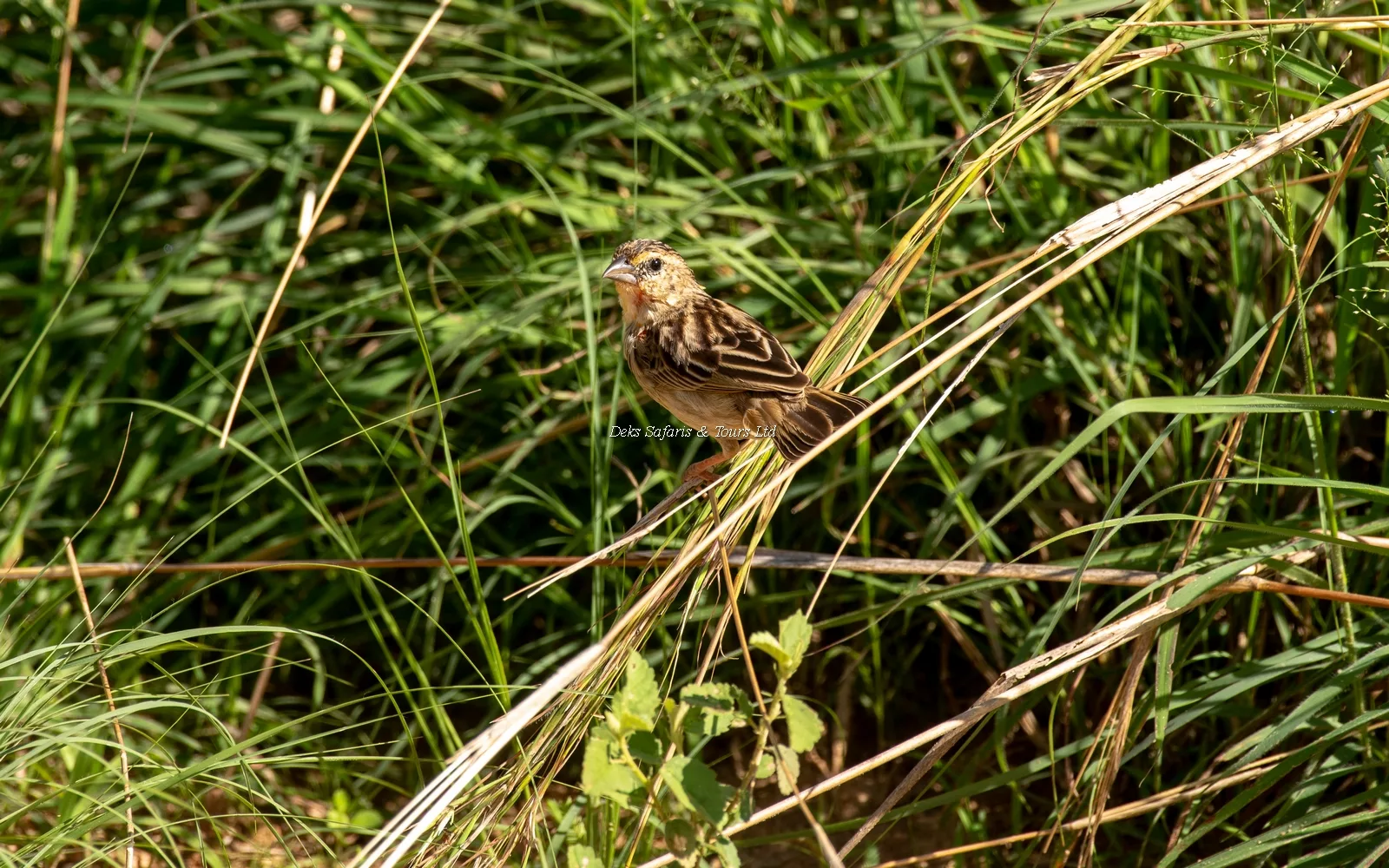
Our Experience Chimpanzee Tracking in Uganda
Our experience of chimpanzee tracking in Uganda was nothing short of extraordinary, immersing us in the lush greenery of the forest as we embarked on an adventure to encounter these fascinating primates in their natural habitat. Setting off in the early morning with our experienced guides, anticipation filled the air as we ventured deeper into the forest of Kibale National Park. The sounds of the jungle surrounded us, heightening our senses and adding to the thrill of the experience.
As we trekked through the dense foliage, guided by the calls of the chimpanzees echoing through the trees, the moment of discovery was unforgettable. Suddenly, amidst the tangle of vines and towering trees, we caught sight of our first chimpanzee, swinging effortlessly through the canopy above. Our hearts raced with excitement as we observed these incredible creatures in their element, witnessing their playful interactions, grooming rituals, and intimate family bonds.
The encounter left a lasting impression on us, deepening our appreciation for the natural world and the importance of preserving these precious habitats for future generations. Our experience of chimpanzee tracking in Uganda was not only a thrilling adventure but also a poignant reminder of the interconnectedness of all life on Earth and the urgent need to protect and conserve our planet’s biodiversity.
Chimpanzee tracking vs Gorilla Tracking in Uganda
Chimpanzee tracking and gorilla tracking are two distinct wildlife experiences offered in Uganda, each offering its own unique thrills and rewards. Chimpanzee tracking typically takes place in lush forests such as Kibale National Park or Budongo Forest Reserve, where visitors have the opportunity to trek through the jungle in search of habituated chimpanzee groups. The experience offers a chance to observe these intelligent primates up close, witnessing their social interactions, feeding behaviors, and vocalizations in their natural habitat. Chimpanzee tracking is generally less strenuous than gorilla tracking, making it accessible to a wider range of visitors.
On the other hand, gorilla tracking is an iconic and highly sought-after wildlife experience, typically taking place in Uganda’s Bwindi Impenetrable National Park or Mgahinga Gorilla National Park. Trekkers embark on a journey through dense forests and rugged terrain to find one of the few remaining mountain gorilla families in the wild. Encountering these majestic creatures in their mountainous habitat is an awe-inspiring and humbling experience, offering a rare glimpse into the world of these critically endangered primates. Gorilla tracking is often more physically demanding than chimpanzee tracking, requiring longer hikes and potentially encountering steeper slopes and higher altitudes.
Both chimpanzee tracking and gorilla tracking offer unforgettable wildlife encounters and contribute to conservation efforts aimed at protecting these endangered primate species and their habitats. Whether observing the playful antics of chimpanzees or coming face-to-face with a mountain gorilla in the misty forests of Uganda, both experiences provide a deep connection to nature and leave a lasting impression on visitors, inspiring a greater appreciation for the importance of wildlife conservation.
Tips for Visiting the Chimpanzees in Uganda
Visiting chimpanzees in Uganda is a thrilling and rewarding experience, and here are some tips to help ensure a memorable and responsible encounter:
- Book your permit in advance: Chimpanzee tracking permits are limited, so it’s essential to book yours well in advance, especially during peak tourist seasons. Permits can be obtained through Deks Uganda Safaris.
- Choose the right destination: Uganda offers several national parks and reserves where chimpanzee tracking is conducted, including Kibale National Park, Budongo Forest Reserve, and Kyambura Gorge in Queen Elizabeth National Park. Research the options and choose the destination that best suits your preferences and interests.
- Follow the guidelines: Once you’re in the forest with the chimpanzees, follow the instructions of your guides closely. Stay quiet, maintain a safe distance, and avoid making sudden movements to minimize disturbance to the chimpanzees and ensure a safe and enjoyable experience for everyone.
- Dress appropriately: Wear lightweight, long-sleeved clothing and sturdy hiking shoes or boots for trekking through the forest. Additionally, consider bringing rain gear and insect repellent, as weather conditions and insect activity can vary.
- Stay healthy: Chimpanzees share many of the same diseases as humans, so it’s essential to minimize the risk of disease transmission. Avoid visiting the chimpanzees if you’re feeling unwell, and follow basic hygiene practices such as washing your hands before and after the trek.
- Respect the environment: Take care not to leave any trash behind and avoid disturbing the natural habitat of the chimpanzees and other wildlife. Leave only footprints and take only memories and photographs.
- Be patient and flexible: Chimpanzee tracking is a wild and unpredictable experience, and sightings are never guaranteed. Be patient and enjoy the journey through the forest, appreciating the sights and sounds of Uganda’s incredible biodiversity.
Tips for Photographing Chimpanzees in Uganda
Photographing chimpanzees in Uganda can be a rewarding experience, capturing the beauty and behavior of these fascinating primates in their natural habitat. By following these tips and approaching chimpanzee photography with patience, respect, and sensitivity, you can capture stunning images while fostering a deeper connection to these incredible creatures and their habitat.
Here are some tips to help you capture stunning photographs while respecting the chimpanzees and their environment:
- Use a telephoto lens: Chimpanzees can be quite active and may move swiftly through the forest canopy. Use a telephoto lens with a focal length of at least 200mm to capture close-up shots of the chimpanzees from a safe distance without disturbing them.
- Be patient and observant: Spend time observing the chimpanzees’ behavior and movements to anticipate photo opportunities. Patience is key to capturing candid moments and expressions that reflect the chimpanzees’ personalities.
- Respect their space: Always maintain a safe distance from the chimpanzees and follow the guidelines provided by your guides. Avoid using flash photography, as it can startle or disturb the chimpanzees, and refrain from getting too close to prevent stress or aggression.
- Capture the environment: Don’t forget to include the lush forest surroundings in your photographs to provide context and depth to your images. Look for interesting compositions, such as chimpanzees framed by foliage or silhouetted against the dappled sunlight filtering through the trees.
- Use natural light: Whenever possible, rely on natural light to illuminate your subjects. Position yourself to take advantage of soft, diffused light, such as early morning or late afternoon when the sun is lower in the sky, to avoid harsh shadows and highlights.
- Be mindful of camera settings: Adjust your camera settings to account for the challenging lighting conditions in the forest, such as a wide aperture to let in more light and a faster shutter speed to freeze motion. Consider using a higher ISO to compensate for low light levels while maintaining image quality.
- Respect the chimpanzees’ privacy: Remember that chimpanzees are wild animals, and it’s essential to prioritize their well-being over getting the perfect shot. Be mindful of their behavior and body language, and avoid disturbing or intruding on their space.
Chimpanzee Tracking Tours in Uganda
Chimpanzee tracking tours in Uganda offer an unparalleled opportunity to explore the country’s lush forests and encounter one of its most iconic inhabitants: the chimpanzee. Led by experienced guides, these tours take visitors on an unforgettable journey through the dense vegetation of national parks and reserves such as Kibale National Park, Budongo Forest Reserve, and Kyambura Gorge. The tours typically begin early in the morning, as guests set out in search of habituated chimpanzee groups, guided by the sounds of their vocalizations echoing through the forest.
During chimpanzee tracking tours, visitors have the chance to observe chimpanzees in their natural habitat, witnessing their social interactions, feeding behaviors, and acrobatic displays as they move through the forest canopy. Knowledgeable guides provide valuable insights into the chimpanzees’ behavior, ecology, and conservation status, enhancing the educational value of the experience. Along the way, participants may also encounter other wildlife species, including various primates, birds, and mammals, further enriching the safari experience.
Chimpanzee tracking tours cater to a range of interests and fitness levels, with options available for both seasoned adventurers and leisurely nature enthusiasts. Whether embarking on a half-day trek or a multi-day expedition, visitors can tailor their experience to suit their preferences, combining chimpanzee tracking with other activities such as birdwatching, nature walks, or cultural encounters with local communities. With its breathtaking landscapes, diverse wildlife, and close encounters with chimpanzees, a chimpanzee tracking tour in Uganda promises an unforgettable adventure in the heart of Africa’s wilderness.


